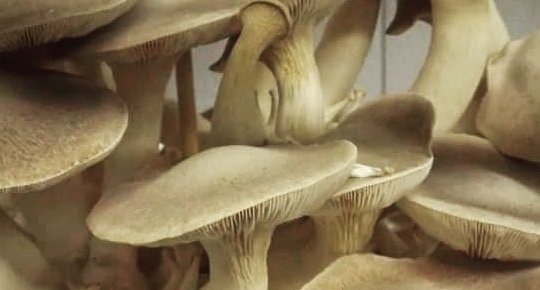
Oyster mushroom (Pleurotus ostreatus)
Mushroom cultivation is a profitable agribusiness and Oyster mushroom (Pleurotus ostreatus) is an edible mushroom having an excellent taste and flavour. It grows wild in the forest and is cultivated in the temperate and sub tropical regions of the world.
The technology of artificial mushroom cultivation is a recent innovation, which stemmed from the realization that the incorporation of non-conventional crops in existing agricultural systems can help in improving the social as well as the economic status of small farmers. Mushrooms are a source of virility and are used in the preparation of many continental dishes. They have anticancerous, anticholesterol and antitumorous properties and are useful against diabetes, ulcer and lung diseases. Mushrooms are a good source of protein, vitamins and minerals. Mushrooms contain about 85-95% water, 3% Protein, 4% Carbohydrates, 0.1% fats, 1% minerals and vitamins. They also contain appreciable amounts of potassium, phosphorus, copper and iron but have low levels of calcium. Mushroom protein is intermediate between that of animals and vegetables. Oyster mushroom has no starch, low sugar content and high amount of fibre, hence it serves as the least fattening food.
Wild mushroom has been a delicacy for many years. It is regarded as meat substitute especially by the rural population. With changes in the climatic patterns, it is becoming difficult harvesting wild mushrooms. The alternative then, is to grow mushrooms domestically. Oyster mushrooms have become the most popular for commercial production.
The growth of oyster mushroom requires high humidity (80-90%) and Temperature (25-30°C) for the vegetative growth called spawn running and lower temperature (18-25°C) for fruit body formation.
Like other mushrooms, oyster mushroom can be grown on various agricultural waste with the use of different technologies. In India, the main substrate for the production of mushroom is wheat straw. Moreover, with the increasing expansion in the fodder industry, there is high demand for straw, thus making it difficult and expensive for commercial mushroom growers to get the straw. If grounded corn cob can support the growth of oyster mushroom, then it would serve as a cheap source of substrate for mushroom growers.
Oyster mushroom consumes significant amount of cellulose, hemicelluloses and nitrogen as their main nourishment source for fruiting body formation and mycelia growth while lignin is rarely used in the formation of fruiting bodies reported higher assimilable nitrogen, cellulose and hemicelluloses for corn cob as against sawdust.
Firstly, the increased level of nutrient available at higher rates would provide more energy for mycelial growth and primordial formation.
The maximum average yield of fruit bodies (>60%) is obtained in the first two flushes on all the substrates.